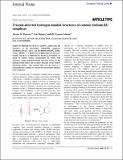Files in this item
Triazole-directed hydrogen-bonded structures of cationic iridium(III) complexes
Item metadata
| dc.contributor.author | Rawson, J.M. | |
| dc.contributor.author | Donato, L. | |
| dc.contributor.author | Zysman-Colman, E. | |
| dc.date.accessioned | 2015-07-21T23:10:53Z | |
| dc.date.available | 2015-07-21T23:10:53Z | |
| dc.date.issued | 2014-09-28 | |
| dc.identifier | 158992549 | |
| dc.identifier | 92bd2981-48fa-486b-99a6-76780936a9b4 | |
| dc.identifier | 84906232131 | |
| dc.identifier | 000344451800021 | |
| dc.identifier.citation | Rawson , J M , Donato , L & Zysman-Colman , E 2014 , ' Triazole-directed hydrogen-bonded structures of cationic iridium(III) complexes ' , CrystEngComm , vol. 16 , no. 36 , pp. 8531-8536 . https://doi.org/10.1039/c4ce00980k | en |
| dc.identifier.issn | 1466-8033 | |
| dc.identifier.other | ORCID: /0000-0001-7183-6022/work/56639094 | |
| dc.identifier.uri | https://hdl.handle.net/10023/7007 | |
| dc.description.abstract | Despite the differing size of the Cl− and PF6− counter-ions, the structures of the heteroleptic iridium(III) complexes, [Ir(dFphtl)2(btl)]Cl, [1]Cl, and [Ir(dFphtl)2(btl)]PF6, [1]PF6, (where dFphtl = 1-benzyl-4-(2,4-difluorophenyl)-1H-1,2,3-triazole and btl = 1,1′-dibenzyl-4,4′-bi-1H-1,2,3-triazolyl) are found to exhibit similar morphologies in which both structures adopt hydrogen-bonded networks driven by the hydrogen-bond donor and acceptor demands of the triazole functional group. The triazole thus can be used as a supramolecular synthon to control the internuclear distance in the solid-state. | |
| dc.format.extent | 6 | |
| dc.format.extent | 764147 | |
| dc.language.iso | eng | |
| dc.relation.ispartof | CrystEngComm | en |
| dc.subject | QD Chemistry | en |
| dc.subject.lcc | QD | en |
| dc.title | Triazole-directed hydrogen-bonded structures of cationic iridium(III) complexes | en |
| dc.type | Journal article | en |
| dc.contributor.institution | University of St Andrews. School of Chemistry | en |
| dc.contributor.institution | University of St Andrews. EaSTCHEM | en |
| dc.identifier.doi | 10.1039/c4ce00980k | |
| dc.description.status | Peer reviewed | en |
| dc.date.embargoedUntil | 2015-07-22 | |
| dc.identifier.url | http://www.rsc.org/suppdata/ce/c4/c4ce00980k/c4ce00980k1.cif | en |
This item appears in the following Collection(s)
Items in the St Andrews Research Repository are protected by copyright, with all rights reserved, unless otherwise indicated.

